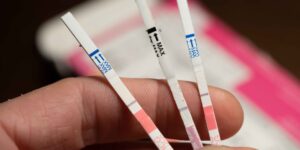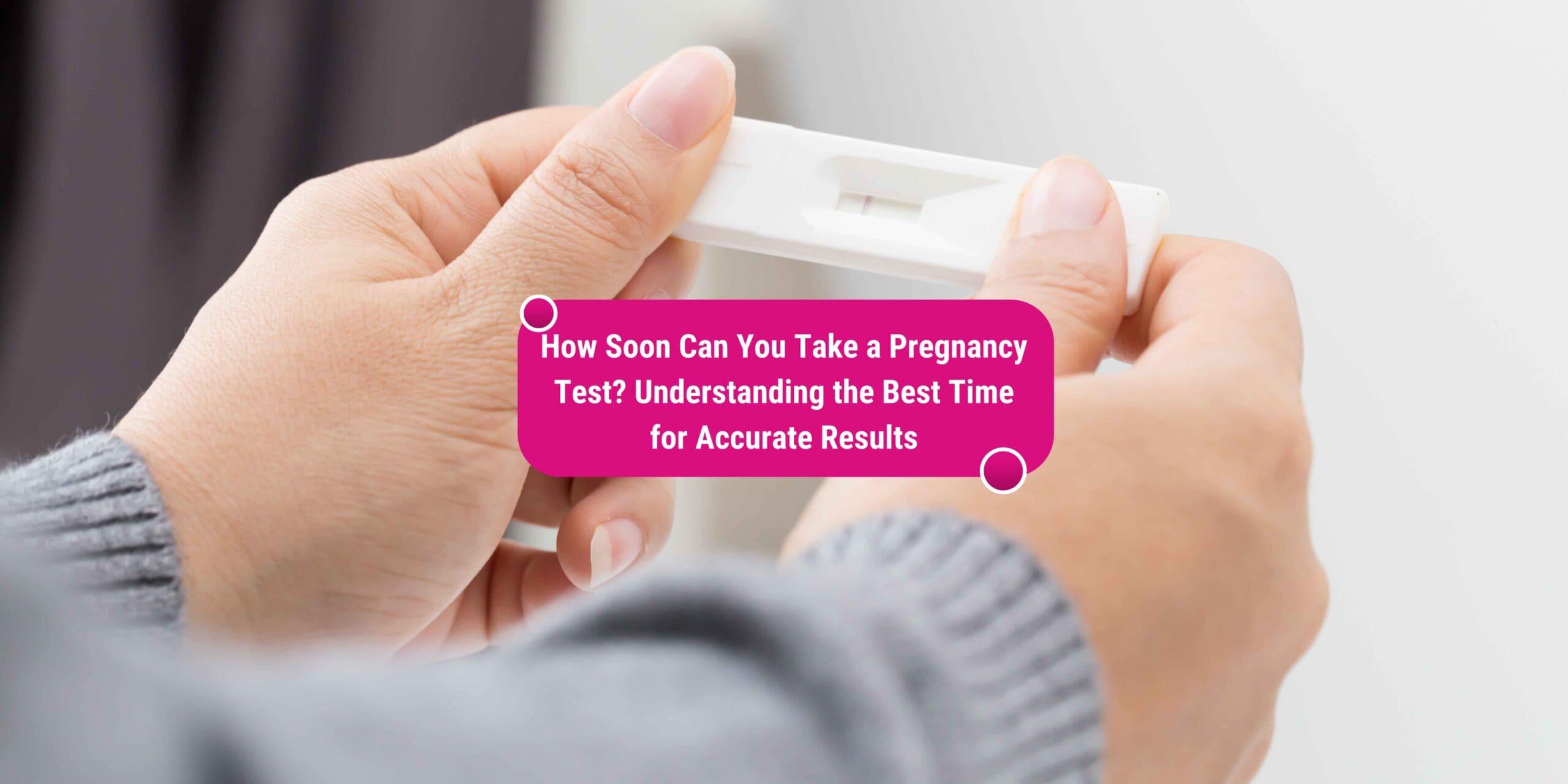Some women know right away when they’re pregnant, sometimes before they even miss a period, while for others that first trimester can go by without even realizing they are expecting. If you suspect that you might be pregnant, you probably are anxious to find out the truth. Taking an at-home pregnancy test or having a blood test done at your doctor or at a clinic is the most reliable way to know for sure.
A lot of women are under the impression that they can take a pregnancy test 7 days after conception. That’s actually not the case at all; if you are pregnant, your body must first produce the hCG hormone, and at this time your body is not really sure it is pregnant yet. If you are in your 4th week of pregnancy but you don’t take a pregnancy test for another two weeks, a test taken two weeks later will come up quicker than one taken a lot earlier. The best time to take a pregnancy test is not only when a woman is physically or mentally ready to deal with the potential consequences of a positive result. These details are important, but a woman should also consider her cycle and body, as some women must wait longer than others to receive an accurate pregnancy test result.
Evidence suggests that cycle regularity is more essential than cycle length when considering time for testing. The guide below breaks down some statistics on when to test based on regular or irregular periods. In addition to discussing testing based on cycle regularity, the guide will also focus on the physical factors that can increase or decrease time until testing. As part of this, we will explore how a woman can predict her ovulation date based on different cycle lengths, and how to find out for sure when ovulation is happening.
Significance of Timing in Pregnancy Testing
The most important factor in obtaining reliable results from a pregnancy test is timing. Testing too early in pregnancy can provide users with a false negative result. This is because the pregnancy test technique detects a hormone known as hCG, which is secreted by the cells of the fertilized ovum. The levels of this hormone increase in the woman’s body as the pregnancy progresses, reaching a climax about two to three months into the term. However, the timing of conception can vary depending on the length of the woman’s menstrual cycle, as ovulation occurs about 14 days prior to the start of menstruation. Given this two-week time frame following ovulation, the fertilized ovum must travel into the womb cavity and implant itself, secreting hCG as it does so. This is why conception is also referred to as the moment of ovulation or the menstrual period minus 14 days.
The fact that a pregnancy test cannot detect ovulation also impacts the interpretation of the result. In general, the chances of obtaining an accurate result are greater as the date of the expected menstrual period approaches, which explains why the instructions often suggest taking the test on the first day of delayed menstruation. The delay can vary, however. If the menstrual cycle is short, the fertilized ovum will implant shortly after ovulation, thus causing a delay of only a few days. On the other hand, in a long menstrual cycle where ovulation is especially late, the body cannot determine the exact moment of implantation, and so a negative reading may deter the woman from taking a pregnancy test until much later on. Additionally, the levels of hCG in urine can vary significantly from one woman to another. It is recommended to seek out a blood test in case of doubt. In this way, one can benefit from advice on timing as well as from professional support.
Purpose and Scope of the Article
This article aims to provide a comprehensive and informative guide for those who are curious about when they can take a pregnancy test. While there is perhaps no area of human life more mysterious than reproduction, the pregnancy test serves to alleviate some of the “unknowns” for those faced with unwanted pregnancy or desiring a child. However, it can sometimes be difficult to understand when would be the ideal time to take a test, and many women may be driven by false assurances provided by advertisements for at-home tests. This article will investigate the science behind pregnancy tests, the variations among commercially available tests, and the factors that could affect the timing of testing.
The first step in taking a test that can offer an accurate reading is to understand that the specific make of test will have information regarding its own individual accuracy. While this article will aim to provide general advice, there are many fine details that should be recognized prior to making definitive decisions, such as the day of the expected period or the ideal time to find “early detection” tests. For this reason, the specific information provided by a test should be obeyed. Another key point that this article aims to highlight is that the contents of the test can make a significant difference. Many women take to the internet to query how soon they can take a pregnancy test, but this information does not serve a clear answer until it is recognized that different tests hold different accuracies and qualities. It is hoped that this article will provide individuals with a variety of methods to interpret the timing of testing, so that the price for an at-home test can be well spent and offer a stress-neutral answer. Finally, it is recognized that the present information aims to inform rather than offer professional advice. The reader should feel no qualms seeking this advice from a medical professional.
How Pregnancy Tests Work
Pregnancy tests work by checking for the presence of a hormone called human chorionic gonadotropin (hCG). This hormone is produced by the placenta as soon as a developing embryo implants in the lining of the uterus. It becomes detectable in the blood a few days later as well as in the urine, where pregnancy tests are typically performed. Pregnancy tests can be performed using either blood or urine samples. A blood test, performed in a medical setting, can check for pregnancy as early as one week after fertilization occurs. Home pregnancy tests typically use urine to look for the presence of hCG in the body.
The hCG hormone rises within the first few days of pregnancy and is typically detectable about ten days after fertilization. Home pregnancy tests can show positive results about a week after the first day of a missed period. You are typically advised to wait to take a pregnancy test until the day your period has not arrived or one day past. While four different kinds of home pregnancy kits are available, midstream tests are easier to use and are hence the most popular. Test sensitivity may vary depending on the manufacturer and how the pregnancy test was designed, and not all pregnancy tests are created equal. Given the various types of pregnancy tests available and the different ways they work, it’s important to understand the science behind the test you are using to obtain accurate results.
Types of Pregnancy Tests
To initiate the testing journey, individuals seeking results can opt for one of two main types of pregnancy tests, namely a urine test or a blood test. Over-the-counter urine tests tend to be the more commonly known variant due to their accessibility and relative ease of use. These tests have a clear advantage. They have no lead time, and virtually everyone has complete access to one. Moreover, most of these tests have the same level of accuracy, which is about 99% (if used correctly). The main downside to these tests is that they usually can’t be used until at least a day or so after an expected period. Blood tests, which are administered by a physician, are the more comprehensive testing option, which means that they can provide definitive results. Pregnancy is detectable in the blood a little earlier than in the urine: within as little as seven to 12 days after conception. Ultimately, the fervent patient who needs to know if she’s pregnant right now might want to bypass the hassle of buying and testing with multiple OTC urine tests and simply go straight to her doctor for a blood test. In addition to standard urine tests, more advanced options exist, such as digital pregnancy tests, which utilize advanced digital technology. The type of test that is chosen will largely dictate the testing process.
Detection of hCG Hormone

The hCG hormone is the ‘pregnancy hormone.’ Your body produces hCG days into a pregnancy. After the fertilized egg attaches to the uterus after conception, hCG levels begin to increase, doubling about every 48 hours. Detecting hCG in a pregnant person’s urine should be relatively easy a week or two after conception.
The hormone production timeline can give you expectations for accurate pregnancy test timing. About a week after conception, about 56 percent of pregnant people show hCG levels of 50 milli-International Units per milliliter (mIU/mL) or higher in their urine. A little over a week after conception, about 10 percent of pregnant people have hCG levels of 100 mIU/mL or higher. The timing was fairly similar in blood. There is “wide variability between individuals” that could have been affected by different factors, such as “the time of ovulation, method of conception, gestational age, oral contraceptive use,” and others. hCG levels can be quite different from person to person. A level of 30 mIU/mL is low, but a level of 2 mIU/mL is even lower and might not register by the lowest threshold of a pregnancy test.
There are varying degrees of pregnancy test sensitivity. Notice how the product descriptions of pregnancy tests vary; some claim to be ‘highly sensitive’ and able to pick up hCG as early as one or two days before a missed period. Others claim such accuracy about four or five days before. Both claims are generally true. There is such a standard for egg and sperm to meet, and then for the fertilized egg to implant in the uterus; they can choose different paths, and many are paths to nowhere. When compared to the endometrial lining of the uterus, hCG rises exponentially for a while. Now, if you want to see if you’ve hit your target, you will likely have better results using the more powerful tool. Where you are with hormone production at any given time can be assessed in the context of where you are in your pregnancy. Use the tool appropriate to the job. Home pregnancy tests typically offer the following ranges of hCG sensitivity: 20 – 100 mIU/mL.
Factors Affecting Test Accuracy
The accuracy of a pregnancy test depends on multiple factors. Perhaps most importantly, you’ve got to take it at the right time of your menstrual cycle. The key marker is a hormone produced by the placenta — the organ that supports the growing baby — called hCG. It’s also sometimes called the “pregnancy hormone.” It is that hormone which these tests are designed to detect. Levels of hCG generally double about every 72 hours in early pregnancy. This is why an early pregnancy test is not always as accurate as one taken a week later; not only is hCG still building up, even in a healthy pregnancy, but it can take longer to reach the levels of detection in very sensitive, early detection tests. Pregnancy tests vary based on how they detect hCG, and different companies have different tests. That’s one reason it’s best to check the instructions that come with the test for the most accurate information on how to test. Not only are poor-quality test kits not as accurately calibrated to detect hCG as soon as some other tests, but they are also more prone to what are known as “evaporation lines” that can be mistaken for a pregnancy. These lines indicate an evaporation of urine on the test and are therefore unreliable if one is looking for a positive result. People can have different levels of hCG in their urine, so not all tests are going to be able to detect a pregnancy as early as the most sensitive tests can. Additionally, the timing of ovulation, when fertilization of an egg by sperm can take place, can vary from cycle to cycle, which can affect the point at which hCG may start to show in the body. This means that some people might not see a positive pregnancy test as soon as someone else if their hCG levels are lower, even with the same super-early detection test. And other people, with irregular cycles or irregular ovulation, might take a test a week later and still end up with a positive pregnancy test because they just conceived later in the menstrual cycle. Certain medical conditions and medications might affect the levels of hCG — and other hormones involved in fertility and pregnancy — in the body, which could affect the results of a pregnancy test.
Timing in Menstrual Cycle
Testing too early in pregnancy, even after a missed menstrual period, can result in a negative test, causing subsequent disappointment when realizing the test was done too soon. Either a blood pregnancy test or a urine qualitative hCG test may be too sensitive to hCG to provide accurate results very early in pregnancy. For accurate results, the best time to take a pregnancy test is about a week after a missed period or approximately two weeks after ovulation. The common link in these two factors is the production of human chorionic gonadotropin (hCG) hormone within the body. Following ovulation, a mature egg may be in the process of either fertilization or degeneration. If the egg is fertilized, it travels down the fallopian tube into the uterus where it implants into the uterine lining. In response to the implantation, the body begins to secrete increasing levels of hCG, which can be detected in maternal serum, blood, and/or urine. Because of these links, a pregnancy test can easily be performed too early in the menstrual cycle or in early pregnancy. Although some tests may be performed earlier, this text will focus on urine qualitative hCG testing and confirmatory serum pregnancy testing. Following ovulation, the luteal phase of the menstrual cycle averages 14-15 days with a range of 10-16 days. Differences in the duration of the luteal phase can also influence hCG detection.
Quality of Test Kit
Just as the best time to take a pregnancy test varies from person to person, the test results also vary owing to the test kit. Every pregnancy test kit in the market may look similar at a glance, but the technology, brand, and material used for producing the kit, as well as the provider’s concerns while producing the kit, matter. There are many types of pregnancy tests and different brands in the market; accordingly, the sensitivity and the advice on whether to use them or not vary. A test with low sensitivity will not produce faster results, which should have occurred if the test had a higher sensitivity. However, some tests with higher sensitivity may occasionally pose some difficulty in reading the results. One out of four cases may present uncomfortable results, but the discomfort will seem much more than the actual case. Storage is also an important factor to consider when you want to take a pregnancy test. The test kit may not react the same as when it is freshly stored after its expiration date. If the expiration date is written on the kit, it must be noted, and the kit should not be used under any circumstances. The package must be kept dry and at room temperature, away from the sun and moisture. Last but not least, the test results may vary between different brands, the reputation of the company that manufactures the test kit, and the reviews. It should be noted that those with many customer feedback may or may not have changed the product, but the policy and practices of the company’s customer protection are really beneficial in case of bad results. Some companies may refund the money or replace the product with additional advantages. In order to get an accurate result, taking a pregnancy test is needed only if the above-mentioned rules and conditions are met.
Best Time to Take a Pregnancy Test
So when is the best time for taking a pregnancy test? Ideally, you should wait for at least one week past the day of your missed period. During this time, pregnancy tests can accurately detect beta-hCG, the hormone they measure in your body. After all, the majority of women are likely to conceive shortly before their menstrual period. That being said, you may also consider an early pregnancy test. One of the benefits of getting tested early is that you have time to make some lifestyle changes if you are not pregnant but hoping to conceive. If it turns out you are expecting, you can simply carry on with your existing plans and disregard the test result. Then again, if an early pregnancy test is negative, it may be a false negative. This is often because the levels of hormone have not reached a specific threshold.
It is also likely that an early pregnancy test will be inaccurate for many individuals due to a hormone threshold not being reached. Nevertheless, the majority of tests suggest results that can be validated if a test is performed after your expected menstrual cycle. Ultimately, the best time to administer a pregnancy test will depend on the length of your menstrual cycle, as well as the test’s level of sensitivity. After your test has been performed, remember to take time to read the results within the correct time frame as indicated on your test directions. By this time, the results should be primary. It is noteworthy that reading the results within the right time frame can prevent a false negative test. A false negative test can occur after the time frame given if ovulation has occurred later than you think, leading to a later period.
Early Pregnancy Testing
Early pregnancy testing has grown in popularity over the years. With today’s highly sensitive home pregnancy tests on the market, individuals can begin testing for pregnancy as early as five days before the missed period. For many reasons, no earlier than seven days before a missed period may be more practical. It is recommended that women test no earlier than seven days before the missed period. Although a good number of women get positive pregnancy test results as early as one week before their periods are expected, these tests are by no means definitive at such an early stage of pregnancy. In fact, the FDA has approved commercially available pregnancy tests for the earliest detection of pregnancy. The extended range of these tests, including very early detection, is provided in an effort to accommodate individual circumstances in which women may desire information about their pregnancy status at the earliest opportunity. Women should be aware that these ultrasensitive tests can be falsely negative, as this early testing can occasionally yield a false negative result because of the small amount of hormone hCG usually present in very early pregnancies or stored before a woman missed her menstrual period. A good general rule is simply to take the test with the first morning urine once there has been a missed period.
It is essential, however, for women to understand and accept that more than one test may be required to detect pregnancy at the earliest possible stage. For early testers, patience is a virtue. Approximately 10% of women may obtain a negative result. It’s important for them to understand that there is a very strong likelihood of still testing positive if they are pregnant. Commercial pregnancy test companies offer a refund or a free test if a false negative occurs. Many early testers do not realize that a beautiful early hCG level curve, starting with little or no pregnancy hormone in the woman’s body, will eventually increase to a point that will yield a positive pregnancy test. In any case, there are emotional benefits to being the first one in the two-week wait period to pee on a pregnancy test. The comfort of knowing may carry many women through what is sometimes a long two weeks.
Recommended Time for Most Accurate Results
The best way to ensure that your results will accurately confirm or rule out pregnancy is to take a test at least one week after your menstrual period is due. In most women, the concentration of hCG in the urine at this time will be high enough to be detected by any of the pregnancy tests that are available for home or clinical use. The reason that it is recommended to take a pregnancy test one week after your period is that women can have a range of menstrual cycles, and ovulation can happen at different times. A typical menstrual cycle takes 28 days to complete, but it is not irregular to have a cycle that is many days shorter or longer than that. If you have ovulated within the typical two-week window and have a shorter 21-day cycle, your period could be delayed almost two weeks and you may not have conceived within the 21-day gap.
It is important to note that when you take a pregnancy test, waiting the entire seven days to take the test will give you the most accurate result using any at-home pregnancy test. Some women may not get a positive test until a week or more after a missed period. Some women’s bodies may also produce hCG levels that can be detected by tests more quickly. Patience and waiting until after the first day of a missed period can improve your overall confidence with the results you receive. When doing these tests over an extended period of time, it is crucial to make note of variations in the reference line. If the reference line diminishes in color saturation, this is not an accurate indicator of a positive test line and could just be due to evaporation.
Continuation of the five right/best ways to produce a pregnancy test.
In conclusion, the point of testing is to get an accurate answer. Accurate answers are achieved by understanding hCG levels, the time you choose to test, and the test you use. There are generally two options: a good time and an expensive test. A good time supersedes the cost of a test. Testing too early can yield a false negative result — it’s not you, it’s science. For accurate results, test when hCG is most likely to be detectable. In the broadest sense, tests aren’t very different from one another in terms of accuracy. If you like how a test is branded and it makes you feel some type of way, by all means go for it. The best way to shop for a test is to read reviews and pick a well-known test, ideally a company that has been making tests for a while. If you want to compare tests, read their submission. None of this is meant to dissuade you from a dollar store test. It’s meant to make you an informed consumer. Remember, even the best test isn’t a perfect one, and if you want an answer now, waiting a week or two isn’t going to change your future. Waiting a week or two will get you closer to the truth. A test is one step along the way. Call your healthcare provider for follow-up. They can test you in the office for free. They will also help you understand what’s going on. A pregnancy test can be used as a home pregnancy test. The sooner you take the pregnancy test, the harder it can be to interpret the answers.



